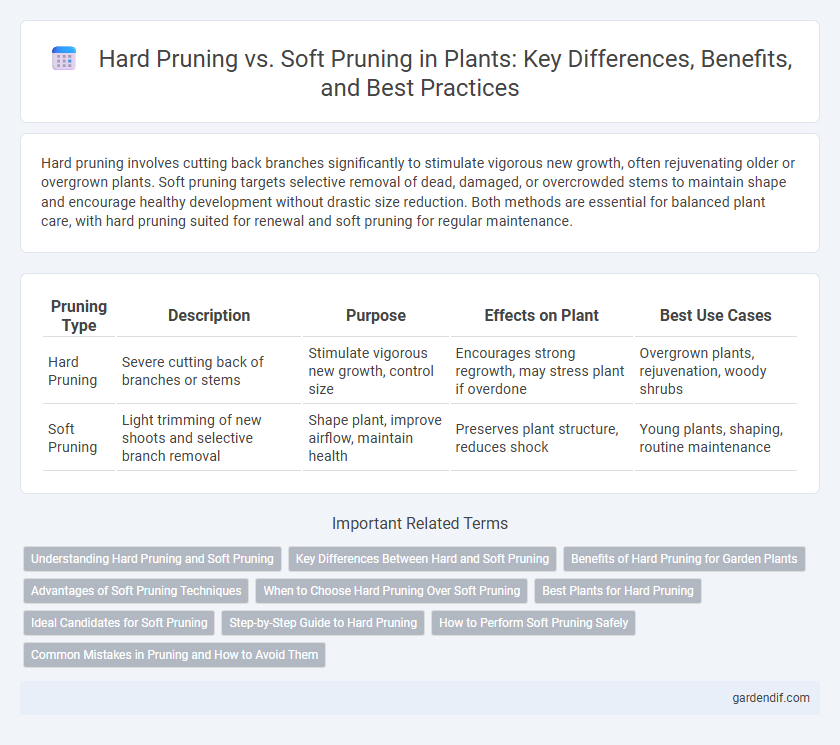
Hard pruning vs Soft pruning Illustration
Hard pruning involves cutting back branches significantly to stimulate vigorous new growth, often rejuvenating older or overgrown plants. Soft pruning targets selective removal of dead, damaged, or overcrowded stems to maintain shape and encourage healthy development without drastic size reduction. Both methods are essential for balanced plant care, with hard pruning suited for renewal and soft pruning for regular maintenance.
Table of Comparison
| Pruning Type | Description | Purpose | Effects on Plant | Best Use Cases |
|---|---|---|---|---|
| Hard Pruning | Severe cutting back of branches or stems | Stimulate vigorous new growth, control size | Encourages strong regrowth, may stress plant if overdone | Overgrown plants, rejuvenation, woody shrubs |
| Soft Pruning | Light trimming of new shoots and selective branch removal | Shape plant, improve airflow, maintain health | Preserves plant structure, reduces shock | Young plants, shaping, routine maintenance |
Understanding Hard Pruning and Soft Pruning
Hard pruning involves the aggressive removal of large branches or stems, often cutting plants back to a framework to stimulate vigorous new growth and maintain plant health. Soft pruning consists of light trimming that shapes the plant, removes dead or damaged foliage, and encourages flowering without drastically altering the plant's overall structure. Understanding the differences between hard and soft pruning helps optimize plant care by matching pruning intensity to species, growth stage, and desired outcomes.
Key Differences Between Hard and Soft Pruning
Hard pruning involves cutting back plants severely, often removing large branches to stimulate new growth and rejuvenate the plant. Soft pruning consists of trimming smaller, selective parts like dead leaves or minor branches to maintain shape and health without stressing the plant. Key differences include the intensity of cuts, timing, and impact on plant recovery, with hard pruning best for revitalization and soft pruning for ongoing maintenance.
Benefits of Hard Pruning for Garden Plants
Hard pruning stimulates vigorous new growth by removing old or damaged branches, which enhances overall plant health and increases air circulation. This method encourages flowering and fruiting, leading to more abundant and higher-quality yields in garden plants. By reshaping plants and controlling size, hard pruning also improves light penetration, promoting better photosynthesis throughout the garden.
Advantages of Soft Pruning Techniques
Soft pruning techniques promote healthier plant growth by minimizing stress and reducing the risk of disease compared to hard pruning. This method allows for gradual removal of foliage, preserving essential nutrients and enhancing photosynthesis efficiency. Gardeners benefit from increased plant resilience and faster recovery when using soft pruning techniques.
When to Choose Hard Pruning Over Soft Pruning
Hard pruning is ideal during the late winter dormancy period when plants need significant rejuvenation or size control, especially for overgrown shrubs like roses or fruit trees. Choose hard pruning for plants that have become woody and unruly, requiring removal of old, unproductive branches to stimulate vigorous new growth. Soft pruning suits routine maintenance but fails to address issues of severe overgrowth or damage that hard pruning effectively manages.
Best Plants for Hard Pruning
Hard pruning promotes vigorous growth in durable plants such as roses, hydrangeas, and fruit trees, which can tolerate extensive cutting back without damage. These species respond well to hard pruning by producing robust stems and abundant blooms, making them ideal candidates for rejuvenation techniques. Selecting plants with strong regenerative capabilities ensures successful hard pruning and enhanced overall health.
Ideal Candidates for Soft Pruning
Ideal candidates for soft pruning include young shrubs, flowering plants, and fruit trees that benefit from gentle shaping without drastic growth interruption. Soft pruning encourages healthy development by removing only dead or weak branches, promoting airflow and light penetration essential for photosynthesis. Plants like hydrangeas, roses, and blueberry bushes respond well to this method, maintaining their structure while enhancing bloom quality.
Step-by-Step Guide to Hard Pruning
Hard pruning involves cutting back plants significantly, often to a few inches above the base, to encourage vigorous new growth and rejuvenate old or overgrown specimens. Begin by sterilizing pruning tools, then remove dead, damaged, or crossing branches, followed by cutting back the remaining stems to a healthy bud or junction. This aggressive technique is ideal for woody shrubs, fruit trees, and perennials needing renewal and should be done during the plant's dormant season to minimize stress.
How to Perform Soft Pruning Safely
Soft pruning involves selectively trimming plant parts to encourage healthy growth and improve shape without causing significant stress. To perform soft pruning safely, use clean, sharp pruning shears to make precise cuts on small stems or branches, always cutting just above a leaf node or bud to stimulate new growth. Avoid removing more than 20-30% of the foliage at once to prevent weakening the plant and minimize the risk of disease or pest infestation.
Common Mistakes in Pruning and How to Avoid Them
Hard pruning often causes excessive stress by removing too much foliage, leading to weak regrowth and vulnerability to pests and diseases. Soft pruning preserves the plant's natural shape and encourages healthy growth, minimizing the risk of shock and dieback. Avoid common mistakes such as cutting too close to the main stem or leaving ragged cuts by using sharp, clean tools and making precise, angled cuts just above a bud.
Hard pruning vs Soft pruning Infographic

 gardendif.com
gardendif.com